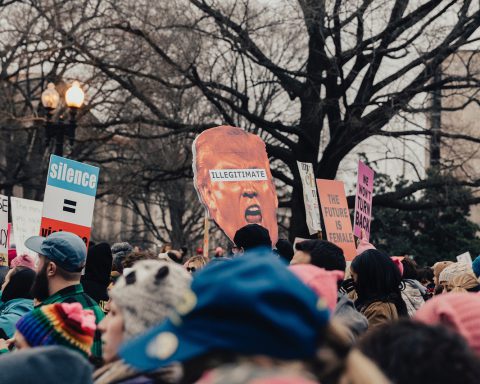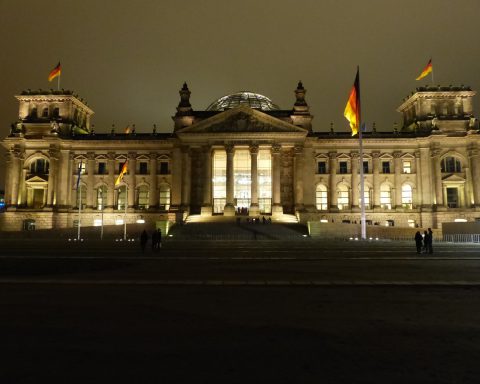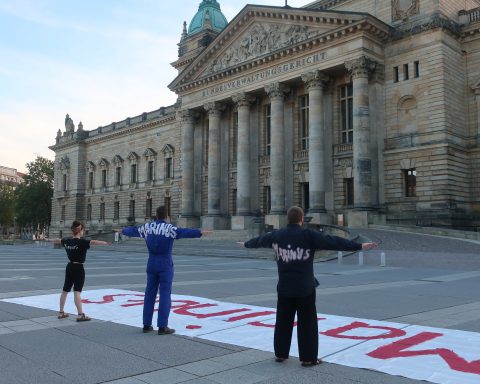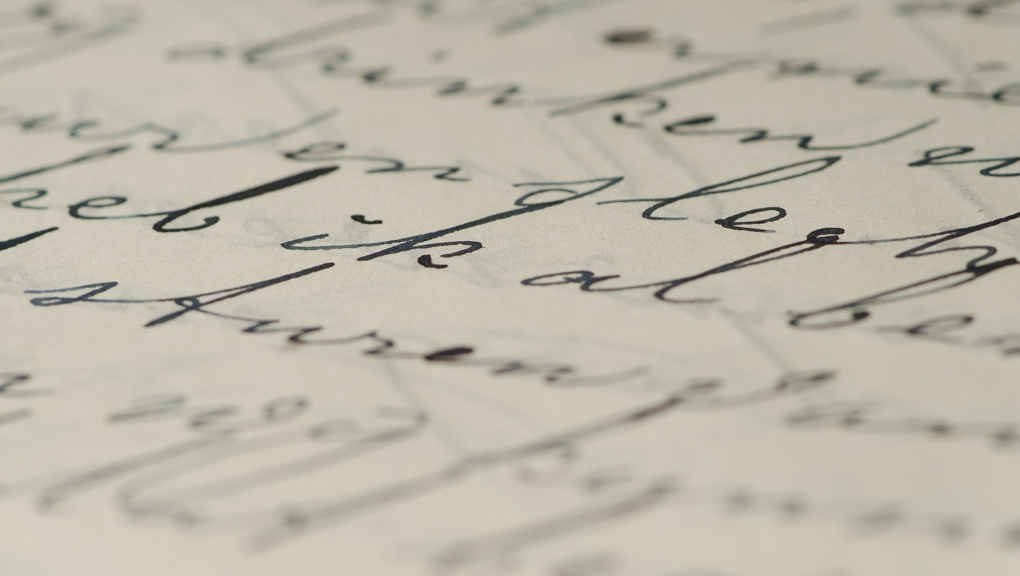They say that Leipzig has always had delusions of grandeur. Leipzigers love to talk about their city as a cosmopolitan European metropolis, referring with pride to Leipzig’s glorious past as the largest fur and tobacco market on the planet.
Every Leipziger knows that their city hosts Europe’s biggest terminal railway station (by area), the continent’s greatest monument (the infamous Völkerschlachtdenkmal) and the world’s 9th-longest tramway system (okay, maybe 10th-longest, but who cares about Bucharest anyway). “Those aren’t delusions, this really is grandeur,” we like to say. “And anyway, without the Nazis, World War II, and the Communists, who knows where Leipzig might be today…” In this article I want to fantasise for a while and imagine what could have been. Brace yourselves for a trip along endless canals connecting the city to the European river system, colossal rows of towering skyscrapers along the outer perimeter of the ring road and spectacular Olympic Games on the familiar grounds of… the Kleinmesse.
As you walk through the streets of Leipzig, one particular name pops up a number of times although you probably have no idea who it refers to: that name is Karl Heine.
Karl-Heine-Schule, Karl-Heine Bogen, Karl-Heine-Platz, Karl-Heine-Straße – that man‘s got it all. But what has he done to earn the Leipzigers’ favour to such an extent? Well, he owned large chunks of land in Leipzig’s Western suburbs in the 19th century and turned the city into one of Germany’s industrial powerhouses. Almost the entirety of Plagwitz and Schleußig is the product of Karl Heine’s visionary foresight as well as a good amount of entrepreneurial ambition. However, there is one aspect of his master plan which was unfortunately never fully realised.
Heine’s grand scheme involved the construction of a fully navigable canal all the way from Plagwitz to the river Saale, which in turn would have linked Leipzig via the Elbe to the North Sea. The remnants of this plan can still be seen in the shape of the famous Karl-Heine-Kanal, as well as in the Elster-Saale-Kanal, which abruptly ends near the IKEA-store in Günthersdorf. Lindenauer Hafen is what’s left of Leipzig’s planned industrial port. Pretty sad, when you think about it, but there is hope: the city administration currently plans to revive Lindenauer Hafen and to fulfil Heine’s dream by completing the Elster-Saale-Kanal. It is likely that in a few years we’ll be able to finally sail all the way from Leipzig to London.
It is no secret that the early 20th century was the era of Leipzig’s heyday.
The population of the city peaked at over 700,000, the trade fair was world-famous and pretty much every book written in German during that period was printed in Leipzig. Futuristic postcards from the period depict flying machines cruising through Petersstraße as well as a high-rise metro spanning across the Marktplatz. A very serious plan was proposed in 1927 by the town hall’s city planner Hubert Ritter. Ritter’s Ringcity foresaw the construction of eight-storey residential and office buildings along the entire outer perimeter of the ring road. His dream involved planting high-rise buildings on both sides of the Hauptbahnhof as well as at six other strategic locations. As is often the case, the plan was only partially realised. If you head to Augustusplatz, go to the fountain outside the Gewandhaus and turn your head towards the ring road, you’re likely to face the Europahaus, which is all that remains of Ritter’s dream.
The Nazi period was as dark for Leipzig as it was for the rest of Europe and resulted in the destruction of much of the city centre. However, the destruction allows us to enjoy a great view from Fockeberg (which is nothing but a huge pile of rubble from the way), and the bombings created lots of space for redevelopment.
The GDR’s Communist leadership had intended to build an extensive metro system that included and far surpassed the dimensions of the current Citytunnel. To compete with the dynamism of Western European cities, an additional metro line was envisioned to traverse the city centre from East to West (i.e. Gottschedstraße to Augustusplatz).
Apart from the construction of the skyscraper at Augustusplatz as a sozialistische Stadtdominante, there were plans to build ten residential high-rise buildings along the ring road. Apparently Ritter’s plans had not yet been shelved altogether. But the Wintergartenhochhaus next to the train station is the only building that was fully realised according to these plans.
Now we’re slowly moving into the 1990s and I’ll tell you about a crazy plan that I can guarantee you’ve never heard about: the total redevelopment of Plagwitz into a European banking capital.
In 1992 Leipzig was left scarred by the impact of inclusion into the capitalist world economy. The local industry practically seized to exist and 20% of the population left the city. This is where Manfred Rübesam, an entrepreneur from Munich, saw his grand opportunity.
Rübesam, whom many Leipzigers believed to be the reincarnation of Karl Heine, bought huge swathes of land in Plagwitz and wanted to build 30 monumental skyscrapers right next to Karl-Heine-Straße and Karl-Heine-Kanal. Leipzig’s new messiah claimed that he had found the support of Saudi investors and thus didn’t seem too worried about the feasibility of his plans. Alas, he failed and declared his insolvency in 2002, but at least he succeeded in renovating the Da Capo-building on Karl-Heine-Straße just opposite his projected dreamscape (you’ve probably spotted the Ilyushin 18-airplane on top of it).
In 2004 Leipzig’s delusions of grandeur reached their pinnacle: The city applied to become Germany’s bid for the Olympic Games 2012 – and won against the likes of Hamburg and Frankfurt.
Tens of thousands of people were cheering on the market square as our mayor convinced the German national Olympic committee of the strength of Leipzig’s application with an emotional cello performance. After the depopulation of the 1990s the whole city was drenched in euphoria. We imagined an Olympic stadium fitting more than 80,000 people replacing the Ferris wheels and rollercoasters of Kleinmesse and an Olympic village which would have been erected along the shores of Lindenauer Hafen. Nothing seemed impossible.
Leipzig’s application included plans for the construction of several concentric circular dual-carriageways through the city’s suburbs which were framed by a motorway ring road. Unfortunately Leipzig lost against Paris, Madrid, London, New York and Moscow, but at least for once we played in the same league with the world’s champions. Some parts of the application actually became a reality. The motorway peripheral around Leipzig was completed in 2007 and the Kanupark at Markkleeberger See (which was intended to host the Olympic rafting competition) opened its floodgates in 2006.
Global city of grandeur – that’s where we’d love to be. Of course, Leipzig’s current provinciality doesn’t reflect that ambition, but anyway, it’s kind of cool that our tiny metropolis sometimes seems like a giant village. And it’s not just any village, but one that inspired urban dreams and visions. By the way, one project that is definitely still on-air is the planned skyscraper at Goerdelerring.
As for me, I can hardly contain my excitement about what the future will bring for Germany’s fastest-growing city.








